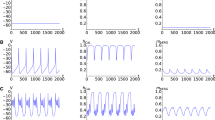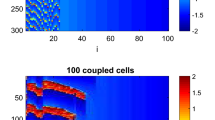Abstract
Spike and burst are the fundamental modes of electrical behavior in many biological cells. Compared with spike, burst plays an important role in information encoding and decoding. It is a relatively slow alternation between active phase of rapid spike and silent phase, which is a vital phenomenon in life science. Thus, understanding the generation and transition mechanism has great significance. In this paper, pancreatic β-cells various firing patterns are investigated as varying the inherent parameter based on the fast/slow dynamics, stability theory and numerical simulation. Transition mechanisms of different firings are also explored using the bifurcation analysis of the fast subsystem. Therefore, this work could give an instructive theoretical guidance in a lot of real physiological experiments of pancreatic β-cells. The results show that as the electrical coupling strength increasing coupled spiking cells can display more complex synchronization. In addition, the coupling strength of the electrically coupled cells could generate a new burst type.
Access this chapter
Tax calculation will be finalised at checkout
Purchases are for personal use only
Similar content being viewed by others
References
Ashcroft, F.M.: Electrophysiology of the pancreatic β-cell. Prog. Biophys. Mol. Biol. 54(2), 87–143 (1989)
Izhikevich, E.M.: Neural excitability, spiking and bursting. Int. J. Bifurcat. Chaos 10(6), 1171–1266 (2000)
Chay, T.R.: Electrical bursting and luminal calcium oscillation in excitable cell models. Biol. Cybern. Y 75(5), 419–431 (1996)
Mosekilde, E., Lading, B., et al.: Bifurcation structure of a model of bursting pancreatic cells. BioSystems 63(1–3), 3–13 (2001)
Belyhk, V.N., Belykh, I.V., et al.: Hierarchy and stability of partially synchronous oscillations of diffusively coupled dynamical systems. Phys. Rev. E 62(5), 6332 (2000)
Perc, M., Marhl, M.: Different types of bursting calcium oscillations in non-excitable cells. Chaos Solitons Fractals 18(4), 759–773 (2003)
Lading, B., Mosekilde, E., et al.: Chaotic synchronization between coupled pancreatic β-cells. Prog. Theor. Phys. Suppl. 139, 164–177 (2000)
Shahriari, Z., Parastesh, F., et al.: The role of coupling factors on the emergence of synchronization and chimera patterns in network of non-locally coupled pancreatic β-cells. EPL 125(6), 60001 (2019)
Meng, P., Wang, Q., Lu, Q.: Bursting synchronization dynamics of pancreatic β-cells with electrical and chemical coupling. Cogn. Neurodyn. 7(3), 197–212 (2013)
De Vries, G.: Sherman, A: From spikers to bursters via coupling: help from heterogeneity. Bull. Math. Biol. 63(2), 371–391 (2001)
Santos, R.M., et al.: Widespread synchronous Ca2+ oscillations due to bursting electrical activity in single pancreatic islets. Pflügers Arch. 418(4), 417–422 (1991)
Wang, H., Wang, Q., Lu, Q.: Bursting oscillations, bifurcation and synchronization in neuronal systems. Chaos Solitons Fractals 44(8), 667–675 (2011)
Tsaneva-Atanasova, K., Zimliki, C., et al.: Diffusion of calcium and metabolites in pancreatic islets: killing oscillations with a pitchfork. Biophys. J . 90(10), 3434–3446 (2006)
Bertram, R., Sherman, A.: Dynamical complexity and temporal plasticity in pancreatic gβb-cells. J. Biosci. 25(2), 197–209 (2000). https://doi.org/10.1007/BF03404915
Pernarowski, M.: Fast and slow subsystems for a continuum model of bursting activity in the pancreatic islet. SIAM J. Appl. Math. 58(5), 1667–1687 (1998)
Yanchuk, S., Maistrenko, Y., et al.: Effects of a parameter mismatch on the synchronization of two coupled chaotic oscillators. Int. J. Bifurcat. Chaos 10(11), 2629–2648 (2000)
Loppini, A., Braun, M., et al.: Mathematical modeling of gap junction coupling and electrical activity in human β-cells. Phys. Biol. 12(6), 066002 (2015)
Lu, Q., Gu, H., et al.: Dynamics of firing patterns, synchronization and resonances in neuronal electrical activities: experiments and analysis. Acta. Mech. Sin. 24(6), 593–628 (2008)
Cha, C., Powell, T., et al.: Analyzing electrical activities of pancreatic β cells using mathematical models. Prog. Biophys. Mol. Biol. 107(2), 265–273 (2011)
Yang, Z., Wang, Q., et al.: Complex dynamics of compound bursting with burst episode composed of different bursts. Nonlinear Dyn. 70(3), 2003–2013 (2012)
Acknowledgement
This work is supported by the National Natural Science Foundation of China (No. 12062004, 11872084), the Guangxi Natural Science Foundation (No. 2020GXNSFAA297240), the Xiangsihu Young Scholars Innovative Research Team of Guangxi University for Nationalities (No. 2019RSCXSHQN02), and the Teaching Quality of Engineering Construction project of Huainan Normal University (No. 2017hsyxkc12).
Author information
Authors and Affiliations
Editor information
Editors and Affiliations
Rights and permissions
Copyright information
© 2021 The Author(s), under exclusive license to Springer Nature Switzerland AG
About this paper
Cite this paper
Ye, M., Zhang, X. (2021). Bifurcation and Synchronization Analysis in Coupled Pancreatic β-cell Models. In: Meng, H., Lei, T., Li, M., Li, K., Xiong, N., Wang, L. (eds) Advances in Natural Computation, Fuzzy Systems and Knowledge Discovery. ICNC-FSKD 2020. Lecture Notes on Data Engineering and Communications Technologies, vol 88. Springer, Cham. https://doi.org/10.1007/978-3-030-70665-4_32
Download citation
DOI: https://doi.org/10.1007/978-3-030-70665-4_32
Published:
Publisher Name: Springer, Cham
Print ISBN: 978-3-030-70664-7
Online ISBN: 978-3-030-70665-4
eBook Packages: Intelligent Technologies and RoboticsIntelligent Technologies and Robotics (R0)




